-
Contents
-
Table of Contents
-
Troubleshooting
-
Bookmarks
Quick Links
™
Vantage Pro2
Console Manual
™
™
For Vantage Pro2 & Vantage Pro2 Plus Weather Stations
Davis Instruments, 3465 Diablo Avenue, Hayward, CA 94545 • 510-732-9229 • www.davisnet.com
Related Manuals for DAVIS Vantage Pro2 Console
Summary of Contents for DAVIS Vantage Pro2 Console
-
Page 1
™ Vantage Pro2 Console Manual ™ ™ For Vantage Pro2 & Vantage Pro2 Plus Weather Stations Davis Instruments, 3465 Diablo Avenue, Hayward, CA 94545 • 510-732-9229 • www.davisnet.com… -
Page 2: Weather Ticker
Connect the equipment into an outlet on a circuit different from that to which the receiver is connected. • Consult the dealer or an experienced radio/TV technician for help. Changes or modification not expressly approved in writing by Davis Instruments may void the warranty and void the user’s authority to operate this equipment. FCC ID: IR2DWW6328…
-
Page 3: Table Of Contents
Calibrating, Setting, and Clearing Variables ……….25 Highs and Lows Mode …………….27 Alarm Mode ………………..29 Graph Mode ………………..31 Troubleshooting and Maintenance …………..34 Vantage Pro2 Troubleshooting Guide …………34 Console Diagnostic Mode …………….36 Console Maintenance ……………..40 One Year Limited Warranty …………..40 Appendix A Weather Data …………….41 Appendix B Specifications …………….
-
Page 4: Welcome To Vantage Pro2 Tm
WeatherLink ® software. Vantage Pro2 stations are available in two basic versions: cabled and wireless. A cabled Vantage Pro2 station transmits outside sensor data from the Inte- grated Sensor Suite (ISS) to the console using a straight-through four-conduc- tor cable.
-
Page 5: Vantage Pro2 Options
Available for Cabled and Wireless stations. Requires Sensor (# 6490) Mounting Shelf (# 6673). Note: Optional wireless stations can only be used with Wireless Vantage Pro2 Stations. ® Optional WeatherLink Software The WeatherLink software and data logger connect your Vantage Pro2…
-
Page 6: Optional Accessories
Creates a dialup connection between the station and the computer. Extension Cables (# 7876) Allows you to place the Cabled Vantage Pro2 ISS further away from the con- sole using the extension cable provided by Davis Instruments. Maximum cable length is 1000’ feet (300 m).
-
Page 7: Installing The Console
Wireless Vantage Pro2 Stations Wireless Vantage Pro2 consoles do not require the use of an AC adapter. You may use the included adapter if you wish, but the three C-cell batteries should power a wireless console for up to nine months.
-
Page 8: Installing Batteries
3. Replace the battery cover. Connecting Cabled Stations Cabled Vantage Pro2 stations come with 100 feet (30m) of cable. This cable is used for connecting the console to the ISS. Maximum cable length from ISS to the console using Davis Instruments cables is 1000 feet. To connect the con- sole to the ISS: 1.
-
Page 9: Console Location
If you have a wireless console, be aware of possible interference from cordless phones or other devices. To prevent interference, maintain a dis- tance of 10 feet between the Vantage Pro2 console and a cordless phone (handset and base). •…
-
Page 10
Console Location Table & Shelf Placement The console kickstand can be set to three different angles allowing five differ- ent display angles. 1. Install the two round rubber feet on the bottom of the console. The rubber feet help prevent damage to furniture and surfaces. 2. -
Page 11: Wall Mounting
8″ (203mm) apart for the #6 x 1″ mounting screws. This is a representation for the mounting hole positions. This template is not true to size. If installing a cabled Vantage Pro2 console with sensor cable running inside the wall, mount the console over an empty switch box.
-
Page 12: Using Your Weather Station
Console Modes The Vantage Pro2 console operates in five different modes: Mode Description Use Setup Mode to enter the time, date, and other information required to Setup calculate and display weather data.
-
Page 13
Setup Mode Screen 1: Active Transmitters Screen 1 displays the message “Receiving from…” and shows the transmitters being received by the console. In addition, an “X” blinks in the lower right- hand corner of the screen every time the console receives a data packet from a station. -
Page 14
Note: Typically, you can use the default transmitter ID setting of 1 unless you are installing one of the optional transmitter stations or a nearby neighbor has a Vantage Pro2 station that uses transmit- ter ID 1 for the ISS. -
Page 15
Setup Mode 2. Use the arrows to scroll through the list of available transmitter IDs and select the ID for your console. 3. Press DONE to move to the next screen. Note: Make a note of the ID selected for retransmit. The console that receives the data from the con- sole you have selected to retransmit should be configured to receive the transmitter ID you selected. -
Page 16
Setup Mode Screen 5: Latitude • Latitude measures distance north or south of the equator. • Latitude is used with longitude to identify your position on earth. If you do not know your latitude and longitude, there are several ways to find out. -
Page 17
Royal Observatory in Greenwich, England. Hayward, California, the home of Davis Instruments, observes Pacific Standard Time. The UTC offset for Pacific Stan- dard Time is -8:00, or eight hours behind Universal Time (UTC). When it’s 7:00 pm (1900 hours) UTC, it’s 19 — 8 = 1100 hours, or 11:00 am in Hayward in winter. -
Page 18
Setup Mode Screen 9: Daylight Savings Status Use this screen to either verify the correct automatic Daylight Savings status or to set Daylight Savings manually. Screen 9: Daylight Savings Status 1. If Daylight Savings setting is MANUAL, press the up and down arrows to turn Daylight Savings Time on or off on the appropriate days of the year. -
Page 19
2. Press DONE to move to the next screen. Screen 12: Rain Collector The tipping bucket in the Vantage Pro2 rain collector has been calibrated at the factory to measure 0.01» of rain with each tip. The ISS comes equipped with a metric adapter that, once installed, takes 0.2 mm readings for every tip of the… -
Page 20
2. Press DONE to move to the next screen. Note: This setting determines when the yearly rain total is reset to zero. Davis Instruments recom- mends a January rain season setting (the default), unless you reside in the west coast of the United States, the Mediterranean coast, experience dry winters in the Southern Hemisphere. -
Page 21: Current Weather Mode
The baud rate setting on your console must match the serial port setting in the software on your computer. If you are using WeatherLink for Vantage Pro2, refer to WeatherLink help for instruc- tions on setting the serial port baud rate on your computer.
-
Page 22: Selecting Units Of Measure
Selecting Units of Measure Note: After pressing 2ND, the 2ND icon displays on the screen for three seconds. Command key sec- ondary functions are enabled during this time. The keys return to normal operation after the icon disappears. • Select a variable and press GRAPH to graph the variable in the Current Weather Mode screen.
-
Page 23: Wind Speed And Direction
Selecting Units of Measure Wind Speed and Direction 1. Press WIND to select wind speed. WIND 2. Wind speed may be displayed in miles per hour (m.p.h.), kilome- ters per hour (km/h), meters per second (m/s), and knots (knots). The 10 minute average wind speed will be displayed in the ticker. A solid arrow within the compass rose indicates the current wind direction.
-
Page 24
Selecting Units of Measure Humidity Press HUM to select outside humidity. Pressing HUM a second time selects inside humidity. Humidity is displayed in percent relative humidity. Each consecutive press of HUM displays humidity readings for any optional humidity, leaf wetness, and leaf temperature stations also connected to your console. -
Page 25
Selecting Units of Measure UV (Ultraviolet Radiation) Press 2ND and UV to display the current UV index. The cur- RAIN rent UV index is the amount of ultraviolet radiation the sensor is currently reading. Press 2ND and UV again to display the accumulated UV index for the day. The accumulated UV index is the total ultraviolet radiation that the sensor has read throughout the day. -
Page 26
Selecting Units of Measure Year–to–date precipitation Press RAINYR a third time to display the year–to–date precipitation record. Yearly rain displays the precipitation accumulated since the 1st of the month you’ve chosen as the beginning of your rain season in Setup Mode (See “Screen 13: Rain Season”… -
Page 27: Displaying The Forecast
Displaying the Forecast Note: A solar radiation sensor is required to take readings listed above. See “Optional Sensors” on page 2. Lamps Press 2ND then press LAMPS to turn on the backlight for the screen LAMPS display. Press 2ND then LAMPS again to turn the backlight off. Use the backlight when the LCD is not clearly visible.
-
Page 28: Calibrating, Setting, And Clearing Variables
You can calibrate inside & outside temperature, inside & outside humidity, as well as any extra temperature/humidity sensor readings you have transmitting to your Vantage Pro2. 1. Select a variable to be calibrated. See “Selecting Weather Variables” on page 18.
-
Page 29: Calibrating Barometric Pressure
Calibrating, Setting, and Clearing Variables 2. Press WIND as necessary to display the wind direction in degrees. 3. Press and release 2ND, then press and hold SET. 4. The wind direction variable will begin to blink. 5. Continue holding the key until the CAL message appears in the ticker. Note: The ticker displays the current wind direction calibration value.
-
Page 30: Highs And Lows Mode
Highs and Lows Mode The Vantage Pro2 records highs and lows for many weather conditions over three different periods: days, months, and years. Except for Yearly Rainfall, all high and low registers are cleared automatically at the end of each period.
-
Page 31
Highs and Lows Mode enter the month that you would like the Yearly Rainfall accumulation to clear. The Yearly Rainfall clears on the first day of the month you chosen. The Yearly High Rain rate clears using the same setting. The following table lists the high and low modes for all the weather variables: Day, Weather Variable… -
Page 32: Alarm Mode
Current Weather mode. Alarm Mode The Vantage Pro2 features more than 30 alarms that can be programmed to sound whenever a reading exceeds or drops below a set value. With the exception of barometric pressure and time, all alarms sound when a reading reaches the alarm threshold.
-
Page 33: Setting Alarms
Alarm Mode sound if the rate of change (in either direction) exceeds the threshold you set. This alarm is updated every 15 minutes. Time The time alarm is a standard “alarm clock” alarm. It sounds for one minute at the set time. Make sure you choose AM or PM, if you’re in 12-hour mode. UV Dose The UV dose alarm sounds when the accumulated UV dose has exceeded the dose you set.
-
Page 34: Graph Mode
Yes — the alarm sounds for 1 minute. Graph Mode The Vantage Pro2 console includes a powerful Graph Mode that allows you to view over 100 graphs of different kinds right on the screen, all without con- necting to a personal computer.
-
Page 35: Viewing Graphs
Graph Mode Viewing Graphs Although the graphs available may vary for each weather variable, you display the graphs in the same way. 1. Select a variable to graph. Only the date, graph, graph GRAPH TEMP OUT icon, and selected variable are visible.
-
Page 36
4. Press the up arrow to shorten the time range. 5. Press the down arrow to lengthen the time range. 6. Press HI/LOW to shift between highs and lows. 7. Press DONE to exit. Vantage Pro2 Console Graphs Weather Variable Available Graphs* Barometric Pressure… -
Page 37: Troubleshooting And Maintenance
Troubleshooting and Maintenance Vantage Pro2 Troubleshooting Guide While your Vantage Pro2 weather station is designed to provide years of trou- ble-free operation, occasional problems may arise. If you are having a prob- lem with your station, please consult this troubleshooting guide before calling Davis technical support.
-
Page 38: Troubleshooting Reception Problems
Troubleshooting Reception Problems While we have tested the Wireless Vantage Pro2 radio extensively, each site and each installation presents its own issues and challenges. Obstructions, particularly metallic ones, often cut down your station’s reception distance. Be sure to test reception between the console and ISS, in the locations you intend to install them, before permanently mounting your ISS or other transmitter(s).
-
Page 39: Console Diagnostic Mode
Console Diagnostic Mode The console’s reception status displays at the lower right corner of the screen. • An “X” flashes for every data packet received by the console. • An “R” displays when the console is trying to re-establish a lost connection. The console tries for 10 minutes to re-establish a connection before going into L Mode.When no data packets have been received for 10 minutes, the console dashes-out any missing sensor readings.
-
Page 40
‡ Note: All values with a * mark the value as being for Davis Instruments Internal use. All values with a mark values that are the same on both the Statistical and Reception Diagnostic screens. Time of day or number of times the anemometer reed switch was seen closed . -
Page 41
Console Diagnostic Mode The total number of bad data packets including missed packets and CRC errors. Missed packets are described as when a data packet is expected, but is not recognized as a data packet by the console. Percentage of good packets received. Total number of good packets received. -
Page 42
Repeater ID displayed is the repeater that the console is set to receive. If the console is not listening to repeaters, this section remains blank. Please see Application Note 25 available on the Davis Instruments Support web page for more information on using repeaters. -
Page 43: Console Maintenance
In some cases, the problem may be that your console firmware doesn’t support what you are trying to do. Use this command to determine the firmware revi- sion level in your console. You can find more information on Vantage Pro2 console firmware versions and changes in the Weather Software Support sec- tion of our website.
-
Page 44: Appendix A Weather Data
Appendix A Weather Data Refer to this appendix to learn more about the weather variables that are mea- sured, displayed, and logged by your Vantage Pro2 Station. Some weather variables require optional sensors. See “Optional Sensors” starting on page 2. Wind The anemometer measures wind speed and direction, and is part of the Inte- grated Sensor Suite (ISS).
-
Page 45: Dew Point
Note: In console firmware versions May 2005 (or version 1.6) or later, Heat Index is equal to the air temperature at or below 0° F (-18° C). For console firmware versions earlier than May 2005 (or version 1.6), Heat Index is equal to the air temperature at or below 57°…
-
Page 46: Barometric Pressure
Rain Vantage Pro2 incorporates a tipping-bucket rain collector in the ISS that mea- sures 0.01» for each tip of the bucket. A metric adapter can be installed to mea- sure 0.2 mm for each tip of the bucket.Your station logs rain data in the same units it is measured in and converts the logged totals into the selected display units (inches or millimeters) at the time it is displayed.
-
Page 47
UV exposure. The readings do not suggest that any amount of exposure is safe or healthful. Do not use the Vantage Pro2 to determine the amount of UV radiation to which you expose yourself. Scientific evi- dence suggests that UV exposure should be avoided and that even low UV doses can be harmful. -
Page 48
Type II (Environment Canada) skin type might choose 0.75 MED as the maximum for the day; in contrast, a person with Type V (Environment Canada) Skin Type might consider 2.5 MEDs a reason- able dose for the day. NOTE: the Vantage Pro2 assumes a Fitzpatrick (Environment Canada) Skin Type of II. -
Page 49: Leaf Wetness
Soil Moisture requires an optional Leaf & Soil Moisture/Temperature Station or Soil Moisture Station and is only available for Wireless Vantage Pro2 Stations. Time A built-in clock and calendar track the time and date. The console automati- cally adjusts for daylight savings time in most of North America, Europe and Australia (and allows manual adjustment elsewhere) and for leap years.
-
Page 50: Appendix B Specifications
Appendix B Specifications See complete specifications for your Vantage Pro2 Station at our website: www.davisnet.com. Console Specifications Console Operating Temperature ..+14° to +140°F (-10° to +60°C) Display Temperature ….+32° to +140°F (0° to +60°C) Non-operating Temperature .
-
Page 51: Console Data Display Specifications
Console Data Display Specifications Console Data Display Specifications Historical Data ….. Includes the past 24 values listed un- less otherwise noted; all can be cleared and all totals reset.
-
Page 52: Weather Data Specifications
Weather Data Specifications Weather Data Specifications Note: These specifications include optional sensors that may not be installed in your Vantage Pro2 Station. Weather Data Specifications Nominal Accuracy Variable Required Sensors Resolution Range (+/-) 26» to 32» Hg; 660 to Barometric 810 mm;…
-
Page 53
Weather Data Specifications Weather Data Specifications Nominal Accuracy Variable Required Sensors Resolution Range (+/-) Solar Radiation Solar sensor 1 W/m 0 to 1800 W/m 5% of full scale Inside +32° to +140°F; 0 to Included in Console 0.1°F; 0.1°C 1°F; 0.5°C +60°C Temperature ISS, Temp Station… -
Page 54: Appendix C
Not all consoles have the capability for repeater support. If your console has firmware dated earlier than May 2005, it does not have the capability to receive Vantage Pro2 wireless repeaters. To check your console’s firmware, press the DONE and up arrow (+) keys. The firmware revision date displays in the ticker tape section of the console.
-
Page 55
shown, the console is configured to listen directly to a station and not to a repeater. In the example below, the console is set up to receive an ISS station on transmitter ID 1 from repeater A. 6. For each station using a repeater, select the station and turn on the repeater function and select the correct repeater ID. -
Page 56: Vantage Pro2 Console Icons
Contacting Davis Technical Support If you have any questions, or encounter problems installing or operating your Van- tage Pro 2 weather station, please contact Davis Technical Support. We’ll be glad to help. (510) 732-7814 — Monday — Friday, 7:00 a.m. — 5:30 p.m. Pacific Time. We are unable to accept collect calls.
ПРОДУКТ ВЫШЕVIEW
фургонtage Pro2™
Руководство пользователя
фургонtage Метеостанция Pro2
Идеально для:
- Метеорологи
- Фермеры
- Любители погоды
- Специалисты по чрезвычайным ситуациям
- Воспитатели
- Исследователи
- Муниципалитеты
Надежное и точное измерение основных параметров погоды
ВанtagМетеостанция Pro2 предоставляет технологии и данные в режиме реального времени, необходимые для реагирования на изменяющиеся условия и принятия своевременных решений.
Разработанный для работы в суровых условиях и год за годом предоставляющий данные с научной точностью, экономичный фургонtage Pro2 предлагает профессиональным наблюдателям за погодой или серьезным энтузиастам погоды надежную работу с широким спектром опций и датчиков.
| Температура | Индекс охлаждения ветром и головы | Влажность и точка росы |
 |
||
| Барометрическое давление | Осадки и интенсивность дождя | Скорость и направление ветра |
 |
ОСНОВНЫЕ ХАРАКТЕРИСТИКИ
| Наблюдайте за погодой так, как она происходит, с обновлениями почти в реальном времени быстро меняющихся данных о ветре, температуре и дожде. | |
| Радиосвязь с расширенным спектром и скачкообразной перестройкой частоты обеспечивает передачу на расстояние до 1,000 футов/300 м и превосходный прием. | |
| Прочная конструкция проходит не менее 10 тестов перед отправкой, включая тщательную калибровку и проверку прочности материала. | |
| Гибкие возможности связи для легкой отправки данных на консоль через беспроводной передатчик на солнечной энергии или кабельную станцию. | |
| Легко включайте дополнительные датчики Davis для создания пользовательской сети датчиков, адаптированной к вашим конкретным потребностям. |
Умный способ view и транслируйте данные о погоде в реальном времени
Консоль WeatherLink революционизирует способ доступа, анализа и понимания ваших гиперлокальных данных о погоде, сообщаемых вашим фургоном.tage Pro2 или ВанtagНабор датчиков Vue® или ваша собственная сеть из нескольких датчиков Davis. Одно интуитивно понятное устройство позволяет получать и отображать данные из локальной сети и подключаться к Wi-Fi, чтобы отправлять данные в облако WeatherLink.
| 80+ | 10+ | сенсорный экран |
| Подключенные датчики к одному WeatherLink Live | Различные типы датчиков | Интерактивный HD-дисплей |
| 1,000FT | Живые данные | Локальная сеть или использование Wi-Fi |
| Расстояние передачи | Обновление данных в реальном времени | Используйте Wi-Fi, чтобы присоединиться к сообществу WeatherLink |
Следите за своей средой
Настройте пользовательскую сеть из более чем 80 датчиков на 8 передатчиках, чтобы вы могли просматривать данные с датчиков в саду, у бассейна, в гараже и в винном погребе — и все это с помощью одной консоли WeatherLink.
Данные viewс WeatherLink® Cloud
Получите доступ к своим данным на Weatherlink.com и App с любого подключенного устройства через WeatherLink Cloud. Используйте API WeatherLink, чтобы легко интегрировать данные о погоде и датчиках в свои собственные инновационные приложения.
? ПОПРОБУЙТЕ МОБИЛЬНОЕ ПРИЛОЖЕНИЕ
С помощью приложения Davis Mobilize вы можете быстро просматривать данные датчиков, создавать настраиваемые отчеты, устанавливать и получать оповещения, а также обмениваться информацией с другими.
ПРОДУКТ ВЫШЕVIEW
Консоль WeatherLink®
Инновации:
- Яркий интерактивный HD-дисплей
- Настраиваемая панель управления
- Персонализированные данные в режиме реального времени viewИНГ
- Создавайте графики и устанавливайте будильники
- Загрузить данные в облако WeatherLink
Умный способ view и транслируйте данные о погоде в реальном времени
Консоль WeatherLink революционизирует способ доступа, анализа и понимания ваших гиперлокальных данных о погоде, сообщаемых вашим фургоном.tage Pro2™ или фургонtagНабор датчиков Vue® или ваша собственная сеть из нескольких датчиков Davis.
Одно интуитивно понятное устройство позволяет получать и отображать данные из локальной сети и подключаться к Wi-Fi для передачи данных в облако WeatherLink.
| Температура | Индекс охлаждения ветром и головы | Влажность и точка росы |
 |
||
| Барометрическое давление | Осадки и интенсивность дождя | Скорость и направление ветра |
 |
И БОЛЬШЕ…
ОСНОВНЫЕ ХАРАКТЕРИСТИКИ
| Используйте яркий сенсорный экран высокой четкости для удобной навигации, viewи анализируйте данные о погоде на одном интуитивно понятном устройстве. | |
| Настройте приборную панель, чтобы отображать до 21 параметра — от температуры до ветра и дождя — и просматривать информацию, которая важна для вас. | |
| Используйте полную базу данных исторических записей, хранящихся прямо на консоли, для создания пользовательских графиков и анализа данных. | |
| Выберите один из сотен параметров и дюжину звуков, чтобы получать уведомления об изменениях в окружающей среде, которые вас больше всего волнуют. | |
| Консоль WeatherLink — это полнофункциональное и мощное средство отображения, хранения и анализа данных, не требующее подключения к сети Wi-Fi. Или вы можете подключиться к Wi-Fi, чтобы присоединиться к сообществу WeatherLink и безопасно и безопасно загружать и обмениваться данными. |
Самая мощная погодная консоль на рынке
Консоль WeatherLink работает как с фургоном,tage Вью и фургонtagе Про2. Смешивайте и подбирайте до 8 метеостанций или датчиков Davis.
Предоставляет вам возможность подключать более 80 датчиков в тысячах комбинаций к одной консоли WeatherLink.
Получите все эти данные с самой высокой скоростью на рынке.
| 80+ | 10+ | сенсорный экран |
| Подключенные датчики к одному WeatherLink Live | Различные типы датчиков | Интерактивный HD-дисплей |
| 1,000FT | Живые данные | Локальная сеть или Wi-Fi |
| Расстояние передачи | Обновление данных в реальном времени | Используйте Wi-Fi, чтобы присоединиться к сообществу WeatherLink |
Следите за своей средой
Настройте пользовательскую сеть из более чем 80 датчиков на 8 передатчиках, чтобы вы могли просматривать данные с датчиков в саду, у бассейна, в гараже и в винном погребе — и все это с помощью одной консоли WeatherLink.
Данные viewс WeatherLink Cloud
Получите доступ к своим данным на Weatherlink.com и App с любого подключенного устройства через WeatherLink Cloud. Используйте API WeatherLink, чтобы легко интегрировать данные о погоде и датчиках в свои собственные инновационные приложения.
? ПОПРОБУЙТЕ МОБИЛЬНОЕ ПРИЛОЖЕНИЕ
С помощью приложения Davis Mobilize вы можете быстро просматривать данные датчиков, создавать настраиваемые отчеты, устанавливать и получать оповещения, а также обмениваться информацией с другими.
© 2022 АЭМ. Все права защищены. ДЕКАБРЬ2022-V1
davisinstruments.com
sales@davisinstruments.com
Документы / Ресурсы
Рекомендации
Скачать
Vantage Pro2
Console Manual
™
For Vantage Pro2 & Vantage Pro2 Plus Weather Stations
™
™
Davis Instruments, 3465 Diablo Avenue, Hayward, CA 94545 • 510-732-9229 • www.davisnet.com
Если у вас отсутствует техническая возможность для скачивания Инструкция по эксплуатации для Davis Instruments Davis Vantage Pro2
вы можете прочесть документ прямо на нашем сайте или
Скачать Davis Instruments Davis Vantage Pro2 Инструкция по эксплуатации
- 1
- 2
- 3
- 4
- 5
- 6
- 7
- 8
- 9
- 10
- 11
- 12
- 13
- 14
- 15
- 16
- 17
- 18
- 19
- 20
- 21
- 22
- 23
- 24
- 25
- 26
- 27
- 28
- 29
- 30
- 31
- 32
- 33
- 34
- 35
- 36
- 37
- 38
- 39
- 40
- 41
- 42
- 43
- 44
- 45
- 46
- 47
- 48
- 49
- 50
- 51
- 52
- 53
- 54
- 55
- 56
- 57
Инструкции для прочих Davis Instruments

Vantage Pro2™
Console Manual
For Vantage Pro2™ & Vantage Pro2 Plus™ Weather Stations

Davis Instruments, 3465 Diablo Avenue, Hayward, CA 94545-2778 U.S.A. • 510-732-9229 • www.davisnet.com
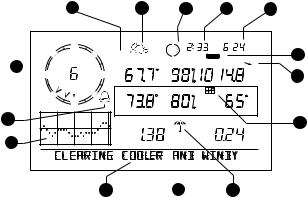
Vantage Pro2 Console Display Features
|
2 |
3 |
4 |
5 |
6 |
|||
|
WIND |
N |
pm |
|||||
|
NW |
NE |
7 |
|||||
|
2nd |
|||||||
|
GRAPH |
|||||||
|
1 |
TEMP OUT |
HUM OUT |
BAROMETER |
||||
|
W |
E |
F |
8 |
||||
|
hPa |
|||||||
|
MPH |
TEMP IN |
HUM IN |
CHILL |
||||
|
SW |
SE |
F |
F |
||||
|
S |
|||||||
|
hr |
|||||||
|
Last |
24 hrs |
Every 1 |
|||||
|
14 |
DAILY |
RAIN RATE |
9 |
||||
|
13 |
in |
in/hr |
|||||
|
Vertical Scale: |
X10 |
STATION NO.1 |
|||||
|
12 |
11 |
10 |
Display Features
|
1. |
Compass Rose |
8. |
Barometric Trend Arrow |
|
2. |
Graph & Hi/Low Mode Settings |
9. |
Graph Icon |
|
3. |
Forecast Icons |
10. |
Current Rain Icon |
|
4. |
Moon Phase Indicator |
11. |
Station Number Indicator |
|
5. |
Time/Sunrise Time |
12. |
Weather Ticker |
|
6. |
Date/Sunset Date |
13. |
Graph Field |
|
7. |
2ND Button Indicator |
14. |
Alarm Icon |
FCC Part 15 Class B Registration Warning
This equipment has been tested and found to comply with the limits for a Class B digital device, pursuant to Part 15 of the FCC Rules. These limits are designed to provide reasonable protection against harmful interference in a residential installation. This equipment generates, uses, and can radiate radio frequency energy and, if not installed and used in accordance with the instructions, may cause harmful interference to radio communications. However, there is no guarantee that interference will not occur in a particular installation. If this equipment does cause harmful interference to radio or television reception, which can be determined by turning the equipment on and off, the user is encouraged to try to correct the interference by one or more of the following measures:
•Reorient or relocate the receiving antenna.
•Increase the separation between the equipment and receiver.
•Connect the equipment into an outlet on a circuit different from that to which the receiver is connected.
•Consult the dealer or an experienced radio/TV technician for help.
Changes or modification not expressly approved in writing by Davis Instruments may void the warranty and void the user’s authority to operate this equipment.
FCC ID: IR2DWW6312
IC: 378810-6312
EC EMC Compliance
This product complies with the essential protection requirements of the EC EMC Directive 2004/108/EC; Low Voltage Directive 2006/95/EC; and Eco-Design Directive 2005/32EC > .05 watt no-load adaptor.
Vantage Pro2 Console Manual
|
Document Part Number: 07395.234 |
Rev. J, 2/14/11 |
|
For Vantage Pro2 Consoles # 6312 & 6312C |
|
|
And Vantage Pro2 Weather Stations # 6152, 6152C, 6153, 6162, 6162C, 6163 |
Vantage Pro® and Vantage Pro2™ are trademarks of Davis Instruments Corp., Hayward, CA. Windows® is a trademark of Microsoft Corporation in the US and other countries. Macintosh® is a trademark of Apple, Inc. in the US and other countries.
© Davis Instruments Corp. 2011. All rights reserved. Information in this document subject to change without notice.
Davis Instruments Quality Management System is ISO 9001 certified.

|
Table of Contents |
|
|
Welcome to Vantage Pro2TM ………………………………………………………………………………. |
1 |
|
Console Features …………………………………………………………………………………………. |
1 |
|
Vantage Pro2 Options ………………………………………………………………………………….. |
2 |
|
Installing the Console ………………………………………………………………………………………… |
4 |
|
Powering the Console ………………………………………………………………………………….. |
4 |
|
Installing the AC Power Adapter …………………………………………………………………… |
4 |
|
Installing Batteries ………………………………………………………………………………………. |
5 |
|
Connecting Cabled Stations ………………………………………………………………………….. |
5 |
|
Console Location ………………………………………………………………………………………… |
6 |
|
Using Your Weather Station ……………………………………………………………………………….. |
9 |
|
Setup Mode ………………………………………………………………………………………………… |
9 |
|
Current Weather Mode ………………………………………………………………………………. |
18 |
|
Selecting Units of Measure …………………………………………………………………………. |
18 |
|
Displaying the Forecast ……………………………………………………………………………… |
24 |
|
Displaying Time & Date or Sunrise & Sunset ………………………………………………. |
24 |
|
Calibrating, Setting, and Clearing Variables …………………………………………………. |
25 |
|
Highs and Lows Mode ……………………………………………………………………………….. |
27 |
|
Alarm Mode ……………………………………………………………………………………………… |
28 |
|
Graph Mode ……………………………………………………………………………………………… |
31 |
|
Troubleshooting and Maintenance ……………………………………………………………………… |
34 |
|
Vantage Pro2 Troubleshooting Guide ………………………………………………………….. |
34 |
|
Console Diagnostic Mode ………………………………………………………………………….. |
36 |
|
Console Maintenance ………………………………………………………………………………… |
40 |
|
One Year Limited Warranty ……………………………………………………………………….. |
40 |
|
Appendix A Weather Data ………………………………………………………………………………… |
41 |
|
Appendix B Specifications ………………………………………………………………………………… |
47 |
|
Console Specifications ………………………………………………………………………………. |
47 |
|
Wireless Communication Specifications ………………………………………………………. |
47 |
|
Console Data Display Specifications …………………………………………………………… |
48 |
|
Weather Data Specifications ………………………………………………………………………. |
49 |
|
Appendix C Wireless Repeater Configuration ……………………………………………………… |
51 |
|
Vantage Pro2 Console Icons ……………………………………………………………………………… |
53 |
i

CHILL
WIND
2ND
Chapter 1
Welcome to Vantage Pro2TM
Welcome to your Vantage Pro2 Weather Station console. The console displays and records your station’s weather data, provides graph and alarm functions, and interfaces to a computer using our optional WeatherLink® software.
Vantage Pro2 stations are available in two basic versions: cabled and wireless. A cabled Vantage Pro2 station transmits outside sensor data from the Integrated Sensor Suite (ISS) to the console using a straight-through four-conductor cable. A wireless Vantage Pro2 station transmits outside sensor data from the ISS to the console via a low-power radio.
|
Note: |
Wireless consoles can also collect data from optional Vantage Pro2 sensors or a |
|
Davis Vantage Vue ISS, and can also retransmit data to other Vantage Pro2 or Van- |
|
|
tage Vue consoles or a Davis Weather Envoy. You can have an unlimited number of |
|
|
consoles — one in each room! |
The Vantage Pro2 Quick Reference Guide included with your station provides an easy to use reference for most console functions.
Console Features
Keyboard & Display
The keyboard lets you view current and historical data, set and clear alarms, change station models, enter calibration numbers, set up and view graphs, select sensors, and read the forecast. The keyboard consists of 12 command keys located next to the screen display and four navigation keys located below the command keys.
A weather variable or console command is printed on each command key. Just press a key to select the variable or function printed on that key.
Each command key also has a secondary function which is printed above the key on the console case. To select the secondary function, press and release 2ND (on the front of the console, upper right corner) and then immediately press the key for that function.
|
After pressing 2ND, the 2ND icon displays above the barometer reading on the screen |
|||
|
for three seconds. All secondary key functions are enabled during this time. Keys |
|||
|
resume normal operation after the icon disappears. |
|||
|
The+ and — navigation keys, along with < and > navigation keys are used |
+ |
||
|
to select command options, adjust values, and to provide additional func- |
|||
|
< |
> |
||
|
tions when used in combination with a command key. |
|||
|
— |
|||
1

Vantage Pro2 Options
Console Modes
The console operates in five basic modes: Setup, Current Weather, Highs and Lows, Alarm, and Graph. Each mode lets you access a different set of console functions or display a different aspect of your weather data.
Vantage Pro2 Options
Optional Sensors & Transmitting Stations
Vantage Pro2 stations are extremely flexible. Use the following optional sensors and wireless stations to enhance the weather monitoring capabilities of your Vantage Pro2. See our web site for complete details:
www.davisnet.com.
|
Optional Sensor and Stations |
Description |
|||||||
|
Anemometer/Sensor Transmitter |
Provides more flexible anemometer placement for wireless |
|||||||
|
stations. With Envoy8X, allows additional solar radiation, |
||||||||
|
Kit (#6332) |
UV, temperature, rain or 3rd party (reporting 0-3 volt) |
|||||||
|
sensors. |
||||||||
|
Vantage Connect (#6620) |
Transmits data from remote ISS to WeatherLink.com via |
|||||||
|
cellular connection. |
||||||||
|
Wireless Leaf & Soil Moisture/ |
Measures and transmits leaf wetness, soil moisture and |
|||||||
|
Temperature Station (#6345) |
temperature data. Also for use with GLOBE. |
|||||||
|
Wireless Temperature Station |
Measures and transmits temperature data. |
|||||||
|
(#6372) |
||||||||
|
Wireless Temperature/Humidity |
Measures and transmits air temperature and humidity |
|||||||
|
Station (#6382) |
data. |
|||||||
|
Solar Radiation Sensor (#6450) |
Measures solar radiation. Required for calculating |
|||||||
|
evapotranspiration (ET). Available for cabled and wireless |
||||||||
|
stations. Requires Sensor Mounting Shelf (#6673). |
||||||||
|
Ultraviolet (UV) Radiation Sensor |
Measures UV radiation. Required for calculating the UV |
|||||||
|
dose. Available for Cabled and Wireless stations. Requires |
||||||||
|
(#6490) |
||||||||
|
Sensor Mounting Shelf (#6673). |
||||||||
|
Note: |
Optional wireless stations can only be used with Wireless Vantage Pro2 Stations. |
|||||||
Optional WeatherLink® Software |
||||||||
|
The WeatherLink software and data logger connect your Vantage Pro2 station |
||||||||
|
directly to a computer, providing enhanced weather monitoring capabilities, a con- |
||||||||
|
tinuous preserved data record, and powerful Internet features. The WeatherLink |
||||||||
|
data logger fits neatly on the console and stores weather data even when the com- |
||||||||
|
puter is turned off. |
||||||||
|
WeatherLink Option |
Description |
|||||||
|
WeatherLink for Windows, USB |
Includes WeatherLink software and USB data logger. Allows you |
|||||||
|
connection (#6510USB) |
to save and view your weather data on your PC. |
|||||||
|
WeatherLink for Windows, serial |
Includes WeatherLink software and serial data logger. Allows |
|||||||
|
connection (#6510SER) |
you to save and view your weather data on your PC. |
|||||||
|
WeatherLink for Macintosh OS |
Includes WeatherLink software and USB data logger. Allows you |
|||||||
|
X, USB connection (#6520) |
to save and view your weather data on your Mac. |
|||||||
|
WeatherLinkIP for Windows XP/ |
Requires a broadband router with available Ethernet port. Allows |
|||||||
|
you to post your weather data directly to the Internet without a |
||||||||
|
Vista/7 (#6555) |
PC. Among other features, allows you to receive e-mail alerts of |
|||||||
|
current weather conditions or simple alarm conditions. |
||||||||
2

Vantage Pro2 Options
|
WeatherLink Option |
Description |
|
|
WeatherLink for APRS, |
Includes WeatherLink software and streaming serial data logger. |
|
|
Windows version, with |
Allows real-time display of current weather conditions for use |
|
|
streaming data logger, serial |
with APRS (Automatic Position Reporting System), for HAM |
|
|
connection (#6540) |
radio users. |
|
|
WeatherLink for Alarm Output, |
Includes WeatherLink software and streaming serial data logger. |
|
|
for Windows, with streaming |
||
|
Gives you the ability to control external devices based on various |
||
|
data logger, serial connection |
||
|
combinations of weather trends and events. |
||
|
(#6544) |
||
|
WeatherLink for Emergency |
Includes WeatherLink software and streaming serial data logger. |
|
|
Response teams, Windows |
||
|
version, with streaming data |
Allows real-time display of current weather conditions for use by |
|
|
logger, serial connection |
emergency response teams. |
|
|
(#6550) |
||
|
WeatherLink for Irrigation |
Includes WeatherLink software and streaming serial data logger. |
|
|
Control, Windows version, with |
||
|
streaming data logger, serial |
Allows intelligent and efficient control of popular automated |
|
|
connection |
irrigation systems using weather data. |
|
|
(#6560) |
Optional Accessories
Accessories are available from your dealer or may be ordered directly from Davis Instruments.
Envoys: Wireless Weather Envoy (#6316,) Envoy8X (#6318)
Performs many of the same functions as a Vantage Pro2 console, but without a display. Use an Envoy to interface your wireless station to a computer, freeing the display for use elsewhere. Weather Envoy can receive the same number and combinations of stations as a Vantage Pro2 console; Envoy8X can receive up to 8 stations in any combination and create a large database.
Sensor Mounting Shelf (#6673)
Required for mounting the optional Solar Radiation and/or UV sensors. The mounting shelf attaches to the base of the rain collector on the ISS.
Additional Vantage Pro2 (#6312) or Vantage Vue Console (#6351)
Enjoy weather information in several rooms.
USB-to-Serial (DB-9) Cable (#8434)
Allows the Serial version of WeatherLink (#6510SER, 6540, 6550, 6560) to connect to a USB port on your computer.
Telephone Modem Adapter (#6533)
Required when connecting station to an external phone modem.
Extension Cables (#7876)
Allows you to place the Cabled Vantage Pro2 ISS further away from the console using the extension cable provided by Davis Instruments. Maximum cable length is 1000’ feet (300 m).
•#7876-040 Cable, 40’ (12 m)
•#7876-100 Cable, 100’ (30 m)
•#7876-200 Cable, 200’ (61 m)
3
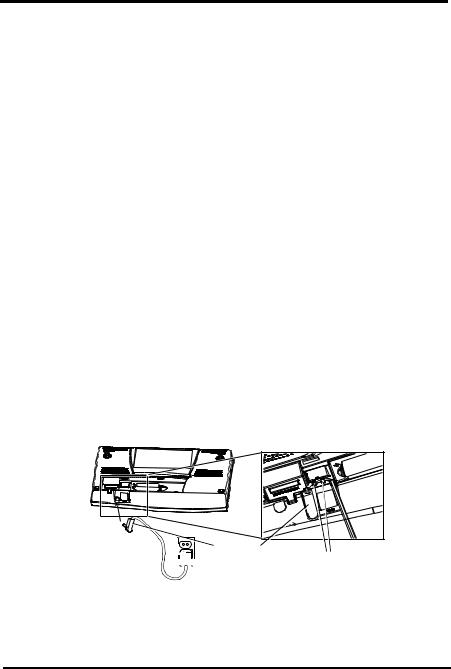
Chapter 2
Installing the Console
The Vantage Pro2 console is designed to give extremely accurate readings. As with any precision instrument, use care in its assembly and handling. Although installing the console is relatively simple, following the steps outlined in this chapter and assembling the Vantage Pro2 correctly from the start will help ensure that you enjoy all of its features with a minimum of time and effort.
Powering the Console
Cabled Vantage Pro2 Stations
Cabled Vantage Pro2 consoles supply power to the Integrated Sensor Suite (ISS) through the console cable. Because of the added power consumption of the ISS, the cabled console requires an AC power adapter used as the main power supply. The console batteries provide backup power for up to four to six weeks.
Wireless Vantage Pro2 Stations
Wireless Vantage Pro2 consoles do not require the use of an AC adapter. You may use the included adapter if you wish, but the three C-cell batteries should power a wireless console for up to nine months.
|
Note: |
When using an AC Power adapter, be sure to use the power adapter supplied with |
|
your Vantage Pro2 Console. Your console may be damaged by connecting the |
|
|
wrong power adapter. The console does not recharge the batteries. Because of this, |
|
|
and because NiCad batteries do not power the console as long as alkaline batteries, |
|
|
use alkaline batteries in the console. |
|
Installing the AC Power Adapter
1.Remove the battery cover located on the back of the console by pressing down on the two latches at the top of the cover.
2.Find the power jack located on the bottom of the console case.
Power Plug
Wrap Cord Around Pins
3.Insert the power adapter plug into the console power jack, then plug the other end of the adapter into an appropriate power outlet.
4
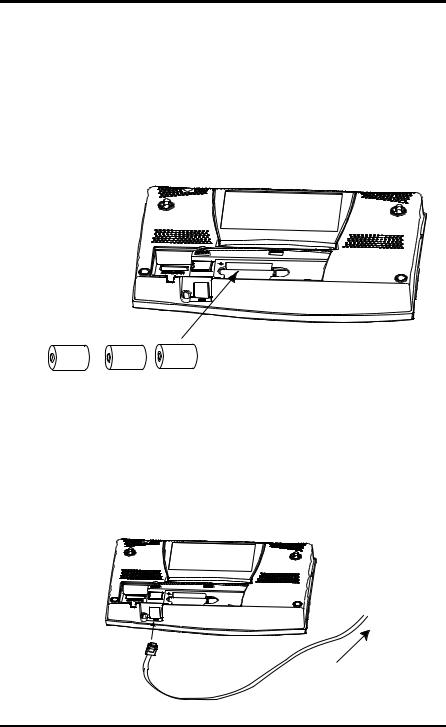
Installing Batteries
4.Check to make sure the console runs through a brief self-test procedure successfully. On power up, the console displays all the LCD segments and beeps twice. A message displays in the ticker banner at the bottom of the console, followed by the first screen that displays during Setup Mode. Press and hold DONE to skip the message and enter into Setup Mode.
Setup Mode guides you through steps required to configure the station. See “Setup Mode” on page 9 for more information.
Installing Batteries
1.Remove the battery cover located on the back of the console by pressing down on the two latches at the top of the cover.
2.Insert three C batteries into the battery channel, negative (or flat) terminal first.
3.Replace the battery cover.
Connecting Cabled Stations
Cabled Vantage Pro2 stations come with 100 feet (30m) of cable. This cable is used for connecting the console to the ISS. Maximum cable length from ISS to the console using Davis Instruments cables is 1000 feet. To connect the console to the ISS:
1.Firmly insert the console end of the straight-through four-conductor wire into the console receptacle marked “ISS” until it clicks into place. Do not force the connector into the receptacle.
To ISS
5
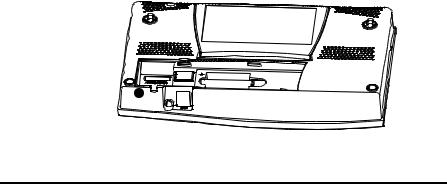
Console Location |
||
|
2. Ensure that the ISS cable is not twisted through the access port. |
||
|
Note: |
The ISS must be assembled and connected to the console so that it is receiving |
|
|
power before the console connection can be tested. |
||
|
Once the console and ISS are both powered up, cable connection should be tested and |
||
|
established. |
||
|
Once the console is powered, it automatically enters Setup Mode. You can step through |
||
|
the Setup Mode options, or exit the Setup Mode to test the connection and sensor read- |
||
|
ings in Current Weather Mode. See “Setup Mode” on page 9 for Setup Mode options. |
||
|
See “Current Weather Mode” on page 18 for viewing and verifying current weather |
||
|
data coming from the cabled console. |
||
|
To verify that the console is receiving data from the ISS through the console connec- |
||
|
tion, see “Cabled ISS Assembly” in the Integrated Sensor Suite Installation Manual. |
Console Location
Place the console in a location where the keyboard is easily accessible and the display is easy to read. For more accurate readings:
•Avoid placing the console in direct sunlight. This may cause erroneous inside temperature and humidity readings and may damage the unit.
•Avoid placing the console near radiators or heating/air conditioning ducts.
•If you are mounting the console on a wall, choose an interior wall. Avoid exterior walls that tend to heat up or cool down depending on the weather.
•If you have a wireless console, be aware of possible interference from cordless phones or other devices. To prevent interference, maintain a distance of 10 feet between the Vantage Pro2 console and a cordless phone (handset and base).
•Avoid positioning a wireless console near large metallic appliances such as refrigerators, televisions, heaters, or air conditioners.
•The console antenna does not rotate in a complete circle. Avoid forcing the console antenna when rotating it.
Table & Shelf Placement
The console kickstand can be set to three different angles allowing five different display angles.
1.Install the two round rubber feet on the bottom of the console. The rubber feet help prevent damage to furniture and surfaces.
6
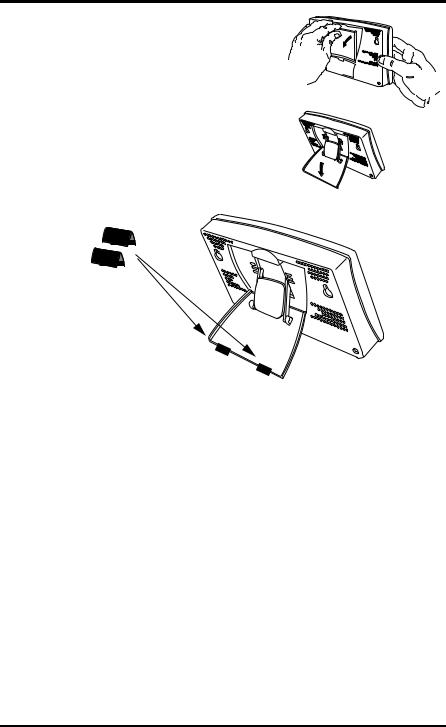
Console Location
2. Lean the kickstand out by pulling on its top edge.
You’ll see the indentation for your finger at the top edge of the console.
3. Slide the catch to rest the kickstand in the appropriate angle.
Choose low angles for display on a coffee table or other low area. Choose higher angles for display on a desk or shelf.
4. Install the two rubber channel feet on the kickstand.
If necessary, pull up on the stand to close it. It will be a little tight, so it’s okay to push hard enough to get it to slide.
7
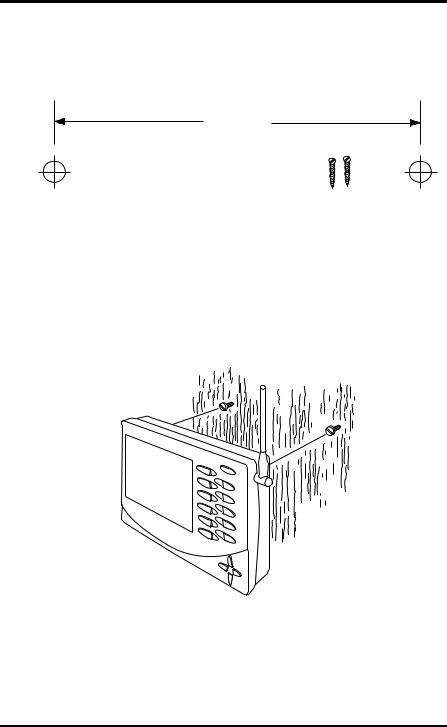
Console Location
Wall Mounting
The console mounts to the wall using two keyholes located on the back of the case. To mount the console on a wall:
1.Use a ruler to mark two mounting hole positions on the wall 8 inches (203 mm) apart.
8″ (203mm)
Drill two 3/32″ or 7/64″ (2.4 to 2.8mm) holes
8″ (203mm) apart for the #6 x 1″ mounting screws.
This is a representation for the mounting hole positions. This template is not true to size.
If installing a cabled Vantage Pro2 console with sensor cable running inside the wall, mount the console over an empty switch box.
2.Use a drill and a 3/32 or 7/64»(2.5 mm) drill bit to drill two pilot holes for the screws.
3.Using a screwdriver, drive the two #6 x 1» pan head self-threading screws into the wall. Leave at least 1/8» (3 mm) between the wall and the heads of the screws.
4.If the kickstand has been pulled out from the case, push it back into its upright and locked position.
5.Guide the two keyholes on the back of the console over the two screws.
8

Chapter 3
Using Your Weather Station
The console LCD screen and keyboard provide easy access to your weather information. The large LCD display shows current and past environmental conditions as well as a forecast of future conditions. The keyboard controls console functions for viewing current and historical weather information, setting and clearing alarms, changing stations types, viewing and/or changing station settings, setting up and viewing graphs, selecting sensors, getting the forecast, and so on.
Console Modes
The Vantage Pro2 console operates in five different modes:
|
Mode |
Description |
|
|
Setup |
Use Setup Mode to enter the time, date, and other information required to |
|
|
calculate and display weather data. |
||
|
Current Weather |
Use Current Weather Mode to read the current weather information, |
|
|
change measurement units, and to set, clear or calibrate weather readings. |
||
|
High/Low |
High/Low Mode displays the daily, monthly or yearly high and low readings. |
|
|
Alarm |
Alarm Mode allows you to set, clear, and review alarm settings. |
|
|
Graph |
Graph Mode displays your weather data using over 100 different graphs. |
|
Setup Mode
Setup Mode provides access to the station configuration settings that control how the station operates. Setup Mode consists of a series of screens for selecting console and weather station options. The screens that display in Setup Mode vary depending on the weather station type (cabled or wireless), or if the console has a WeatherLink connection already established. (See the WeatherLink Getting Started Guide for more information on connecting your console to your computer.)
Setup Mode Commands
Setup Mode displays when the console is first powered. This mode can be displayed at any time to change any of the console/weather station options. Use the following commands to enter, exit and navigate Setup Mode:
• Enter Setup Mode by pressing DONE and the — key at the same time.
|
Note: |
The console automatically enters Setup Mode when first powered. |
•Press DONE to move to the next screen in the Setup Mode.
•Press BAR to display the previous screen in the Setup Mode.
•Exit Setup Mode by pressing and holding DONE until the Current Weather screen displays.
9
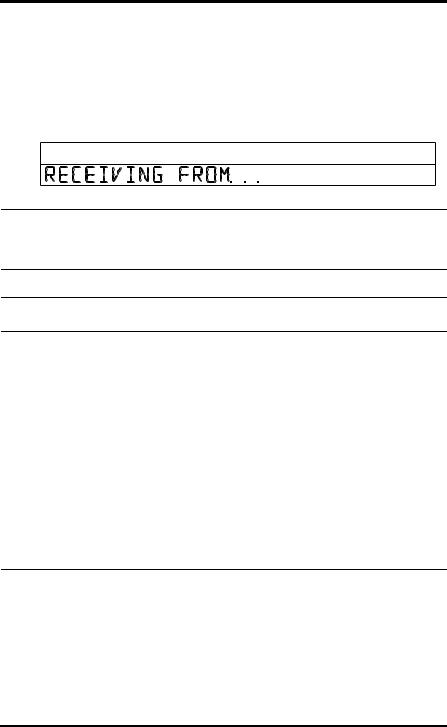
Setup Mode
Screen 1: Active Transmitters
Screen 1 displays the message “Receiving from…” and shows the transmitters being received by the console. In addition, an “X” blinks in the lower right-hand corner of the screen every time the console receives a data packet from a station. The rest of the LCD screen is blank.
If you have a cabled station, or if your wireless ISS uses the factory settings and you are receiving the signal, the screen displays “Receiving from station No. 1.” Any optional stations that have been installed should also display.
|
STATION NO.1 4 |
|
|
Screen 1: Active Transmitters |
|
|
Note: |
An ISS or optional station must be powered for the console to recognize it. Refer to |
|
the Integrated Sensor Suite Installation Manual or optional station installation instruc- |
|
|
tions for more information. It make take several minutes for the console to acquire |
|
|
and display a Transmitter ID. |
1. Make a note of the station number(s) listed on the screen.
|
Note: |
If a Vantage Pro2 or Vantage Vue ISS has been installed in your area, its ID number |
|
may also be displayed. |
2. Press DONE to move to the next screen.
The console can receive signals from up to eight transmitters total, but there is a limit on the number of certain types of transmitters. The table below lists the maximum number of stations allowable for a receiver:
|
Station Type |
Maximum Number |
|
|
Integrated Sensor Suite (ISS) |
1 |
|
|
Anemometer Transmitter Kit (replaces |
1 |
|
|
ISS anemometer) |
||
|
Leaf & Soil Moisture/Temperature Station |
2* |
|
|
Temperature Station |
8 |
|
|
Temperature/Humidity Station |
8 |
|
Maximum Number of Transmitters in a Network with One Receiver
*Two are allowable only if both stations are only partially populated. For example, A network can either have both a Leaf Wetness/Temperature station and a Soil Moisture/Temperature station, or it can have one combined Leaf Wetness and Soil Moisture/Temperature station.
|
Note: |
Listening to more than one transmitter may reduce battery life significantly. |
Screen 2: Configuring Transmitter IDs — Wireless Only
(If you have a cabled station, press DONE and continue on to “Screen 4: Time & Date” on page 12.)
Setup screen 2 allows you to change the ISS transmitter ID and to add or remove optional transmitter stations. The default transmitter ID setting is “1” (ISS), which works fine for most installations.
10
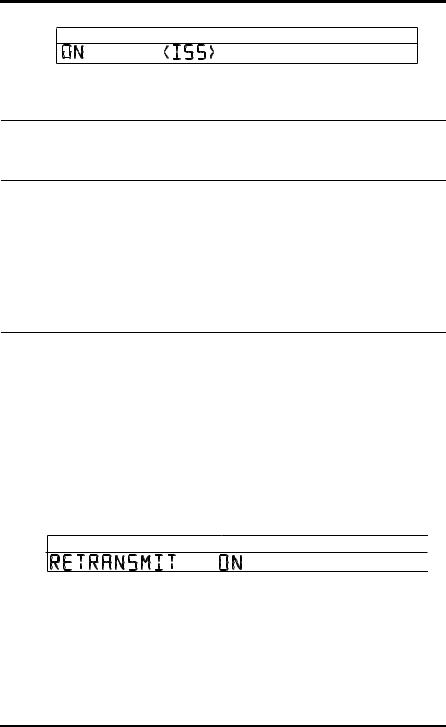
Setup Mode
|
1 |
|
|
Screen 2: Transmitter ID configuration |
|
|
If you have a cabled station, or if you have a wireless station and are using the |
|
|
default transmitter ID setting, press DONE to move to the next screen. |
|
|
Note: |
Typically, you can use the default transmitter ID setting of 1 unless you are installing |
|
one of the optional transmitter stations. However, if you are having trouble receiving |
|
|
your station, there may be another ISS with ID 1 operating nearby. Try changing the |
|
|
ID of both the console and ISS to another ID number. |
3.Press the < and > keys to select the transmitter ID.
When you select a transmitter ID, the ID number is displayed on the screen as well as the current configuration.
4.Press the + and — keys to toggle console reception of signals from transmitters using that ID on and off.
5.Press GRAPH to change the type of station assigned to each transmitter. Scroll through the station types — ISS, TEMP, HUM, TEMP HUM, WIND, RAIN, LEAF, SOIL, and LEAF/SOIL — until the correct type appears.
6.Press DONE to move to the next screen.
|
Note: |
This screen contains functionality for enabling repeaters. If the word “Repeater” dis- |
|
plays in the right corner of the screen and you are not using repeaters as part of your |
|
|
network, see “Clearing Repeater ID” on page 52. If you are using repeaters as part of |
|
|
your network see “Wireless Repeater Configuration” (Appendix C) on page 51 for |
|
|
configuring repeaters on the console. |
|
Screen 3: Retransmit — Wireless Only
If you have a cabled station, press DONE and go to “Screen 4: Time & Date” on page 12.
The console can retransmit the data it receives from the ISS to other Vantage Pro2 or Vantage Vue consoles using the retransmit feature. By toggling the feature on, the console becomes another transmitter that requires its own unique ID to transmit the data received from the ISS.
2
Screen 3: Retransmit
1.Press the + or — keys to turn the retransmit function on and off. The first available transmitter ID not used by the ISS or any optional sensor is automatically assigned. Data from the ISS is the only data that can be retransmitted by the console.
When retransmit has already been enabled, pressing the < and > keys changes the Transmitter ID used for retransmit.
2.Use the > key to scroll through the list of available transmitter IDs and select the ID for your console.
3.Press DONE to move to the next screen.
11
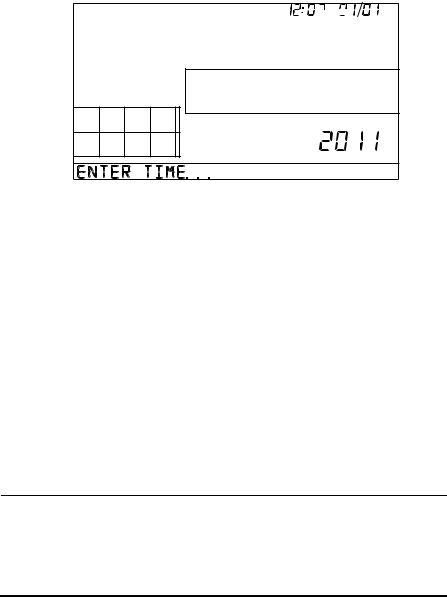
|
Setup Mode |
|
|
Note: |
Make a note of the ID selected for retransmit. The console that receives the data |
|
from the console you have selected to retransmit should be configured to receive the |
|
|
transmitter ID you selected. See “Screen 2: Configuring Transmitter IDs — Wireless |
|
|
Only” on page 10 for more information. |
|
Screen 4: Time & Date
The first time you power-up the console, enter the correct date and local time.

Screen 4: Time & Date
To change the time and date:
1.Press the < and > keys to select the hour, minute, month, day or year. The selected time or date setting blinks on and off.
2.To change a setting, press the + and — keys to adjust the value up or down.
To choose a 12-hour (default in US models) or 24-hour clock (default in EU and UK models), first select either the hour or minute setting, then press 2ND and immediately press UNITS. This toggles the clock setting between the two clock types.
To choose between a MM/DD (default in US models) or DD.MM (default in EU and UK models) display for the date, first select either the day or month setting, then press 2ND and immediately press UNITS. This switches the console from one date display to the other.
3.Press DONE to move to the next screen.
Screen 5 and Screen 6: Latitude and Longitude
The console uses latitude and longitude to determine your location, allowing it to adjust the forecast and calculate the times for sunset and sunrise.
•Latitude measures distance north or south of the equator.
•Longitude measures distance east or west of the Prime Meridian, an imaginary line running north and south through Greenwich, England.
|
Note: |
You can find your latitude and longitude by searching the internet (for example: |
|
googlemaps.com, earth.google.com or earthtools.org). Many atlases and maps |
|
|
include latitude and longitude lines. You can also talk to the reference department of |
|
|
your local library, call your local airport, or search on the Internet. |
|
12
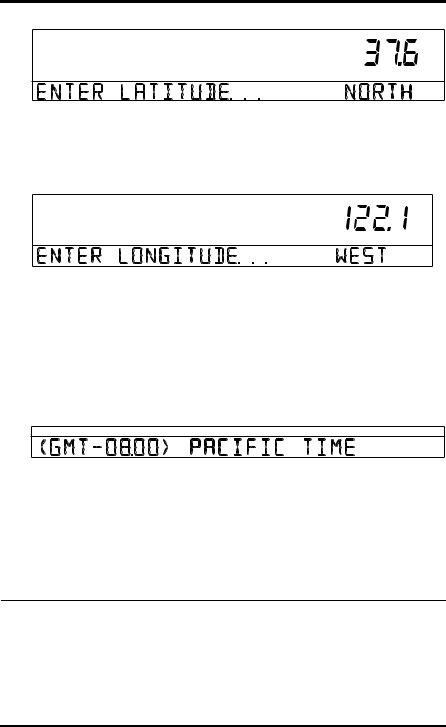
Setup Mode
The more accurate you are, the better; however, a reasonable estimate will work, too.
Screen 5: Latitude
1.Press the < and > keys to move between fields.
2.Press the + and — keys to change the settings up or down.
3.To select between SOUTH or NORTH, press 2ND and then UNITS.
4.Press DONE to move to the Longitude screen.
Screen 6: Longitude
1.Press the < and > keys to move between fields.
2.Press the + and — keys to change the settings up or down.
3.To select the East or West Hemisphere, press 2ND, then UNITS.
4.Press DONE to move to the next screen.
Screen 7: Time Zone
The console is pre-programmed with a combination of US time zones and the names of major cities representing time zones around the world. You can also configure your time zone using the Universal Time Coordinate (UTC) offset.
|
Screen 7: Time Zone |
|
|
Note: |
UTC offset measures the difference between the time in any time zone and a stan- |
|
dard time, set by convention as the time at the Royal Observatory in Greenwich, |
|
|
England. Hayward, California, the home of Davis Instruments, observes Pacific Stan- |
|
|
dard Time. The UTC offset for Pacific Standard Time is -8:00, or eight hours behind |
|
|
Universal Time (UTC). When it’s 7:00 pm (1900 hours) UTC, it’s 19 — 8 = 1100 hours, |
|
|
or 11:00 am in Hayward in winter. When daylight saving time is observed, an hour is |
|
|
added to the offset time automatically. Use this function in correlation with Screen 8, |
|
|
Daylight Saving Settings. |
1.Press the + and — keys to cycle through time zones.
2.If your time zone is not shown, press 2ND then press the + and — keys to set your UTC offset.
3.Press DONE to select the time zone or UTC offset shown on the screen and move to the next screen.
13
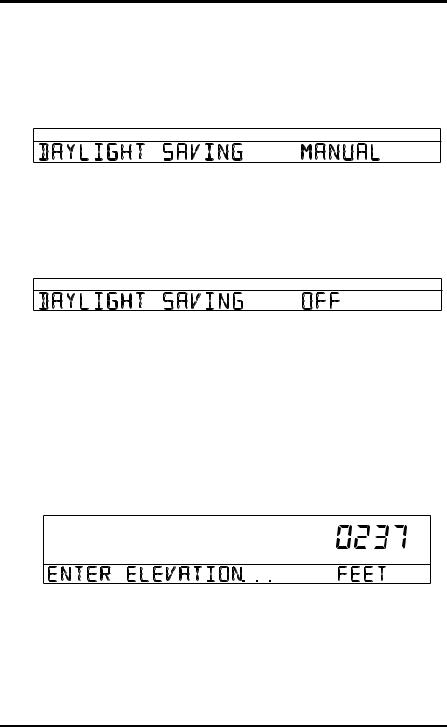
Setup Mode
Screen 8: Daylight Saving Settings
In most of North America (except Saskatchewan, Arizona, Hawaii, and the Mexican State of Sonora); and Europe use the AUTO daylight saving setting. The console is preprogrammed to use the correct starting and stopping dates for daylight saving time in these areas, based on the time zone setting in screen 7.
Stations located outside North America and Europe, or in areas that do not observe daylight saving time should use the MANUAL setting.
Screen 8: Daylight Saving Settings
1.Press the + and — keys to choose Auto or Manual.
2.Press DONE to move to the next screen.
Screen 9: Daylight Saving Status
Use this screen to either verify the correct automatic daylight saving status or to set daylight saving manually.
Screen 9: Daylight Saving Status
1.If Daylight Saving setting is MANUAL, you will have to set the time correctly when it changes. However, to maintain accurate calculations, you also need to use the + and — keys to turn daylight saving time on or off on the appropriate days of the year. If you have an AUTO daylight saving setting, the console displays the appropriate setting based on the current time and date.
2.Press DONE to move to the next screen.
Screen 10: Elevation
Meteorologists standardize barometric pressure data to sea level so that surface readings are comparable, whether they’re taken on a mountainside or by the ocean. To make this same standardization and ensure consistent readings, enter your elevation in this screen.
|
Screen 10: Elevation |
|
|
Note: |
If you do not know your elevation, there are several ways to find out. Many atlases |
|
and almanacs include elevation for cities and towns. You can also check with the ref- |
|
|
erence department of your local library, or refer to internet resources. (See “Screen 5 |
|
|
and Screen 6: Latitude and Longitude” for a list of web sites.) The more accurate you |
|
|
are, the better; but a reasonable estimate works too. |
|
14






















